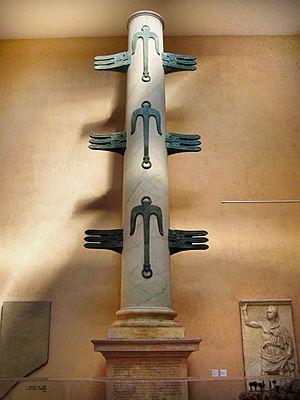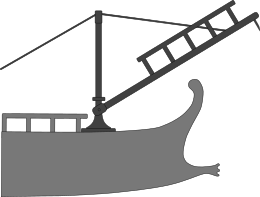Gaius Duilius facts for kids
Quick facts for kids
Gaius Duilius
|
|
|---|---|

Reproduction of the victory column of Gaius Duilius
|
|
| Dictator of Rome | |
| In office 231 BC |
|
| Censor of Rome | |
| In office 258 BC |
|
| Consul of Rome | |
| In office 260 BC |
|
| Personal details | |
| Nationality | Roman |
| Awards | Triumph |
| Military service | |
| Allegiance | Rome |
| Branch/service | Roman navy |
| Battles/wars |
|
Gaius Duilius was an important Roman general and leader who lived around 260–231 BC. As a consul in 260 BC, during the First Punic War, he led Rome to its very first victory at sea. He achieved this by defeating the powerful Carthaginians at the Battle of Mylae. Later, he served as a censor in 258 BC. He was also named dictator in 231 BC to help with elections, but he didn't lead any more battles after his great naval win.
Contents
Who Was Gaius Duilius?
Gaius Duilius came from a family that wasn't very famous in Rome. His father and grandfather were both named Marcus Duilius. While one person named Caeso Duilius was a consul in 336 BC, the Duilius family wasn't widely known for important leaders until Gaius came along.
His Amazing Career
In 260 BC, Duilius became one of the two consuls, who were like the top leaders of Rome. He was first put in charge of Rome's army on land in Sicily. This was during the First Punic War, a big fight against Carthage. His fellow consul, Gnaeus Cornelius Scipio, was in charge of the Roman navy.
Rome quickly built 120 warships. They sent them to Sicily in 260 BC for the crews to practice. Scipio sailed with the first 17 ships to the Lipari Islands, near Sicily. He tried to capture the main port there, Lipara. The Carthaginian fleet, led by Hannibal Gisco, was based about 100 kilometers (60 miles) away.
When Hannibal heard about the Romans' move, he sent 20 ships. Scipio's new Roman sailors weren't ready for battle. They quickly gave up, and Scipio himself was captured. All of the Roman ships were taken, most without much damage. Because of this, Duilius had to take over the Roman fleet. Soon after, Hannibal was scouting with 50 Carthaginian ships when he met the full Roman fleet. He managed to escape, but he lost most of his ships.
Sailing warships skillfully needed a lot of practice. The Romans were new to sea battles, so they were at a disadvantage against the experienced Carthaginians. To fix this, the Romans invented a clever device called the corvus. This was a bridge, about 1.2 meters (4 feet) wide and 11 meters (36 feet) long. It had a heavy spike on one end. When a Roman ship got close to an enemy ship, they would drop the corvus. The spike would pierce the enemy ship's deck, holding the two ships together. This allowed Roman soldiers, who were excellent fighters on land, to board the enemy ships. This was different from the usual tactic of ramming ships.
Duilius soon heard that a Carthaginian group, again led by Hannibal Gisco, was attacking Mylae. He quickly sailed to meet them. The two fleets clashed off the coast of Mylae in the Battle of Mylae. Hannibal had 130 ships, and Duilius had about the same number. The Carthaginians expected to win easily. Their crews were more experienced, and their ships were faster. They rushed forward to attack the Romans.
The first 30 Carthaginian ships were caught by the corvus. Roman soldiers quickly boarded them and captured them. Even Hannibal's own ship was taken, though he escaped in a small boat. Seeing this, the remaining Carthaginians tried to go around the Roman ships to attack their sides or rear. But the Romans reacted well and captured another 20 Carthaginian ships. The remaining Carthaginian ships were faster and managed to get away. This battle was Rome's very first victory at sea! After this great win, Duilius sailed to help the Roman city of Segesta, which was under attack.
More Successes and Lasting Impact
After his big naval victory, Duilius went back to leading the Roman armies in Sicily. He landed near Termini and helped lift the siege of Segesta by the Carthaginian Hamilcar. Then, he successfully attacked the fortress of Macella.
As his time as consul was ending, Duilius returned to Rome. He held elections and, in early 259 BC, celebrated a Roman triumph. This was a huge parade and celebration for a military victory. It was the first triumph ever held for a naval win! With some of the treasures from his victory, Duilius built a temple to Janus. A special column, decorated with the ramming beaks (called rostra) from the captured Carthaginian warships, was put up in the Forum to remember his victory. He was also given a special honor: a torchbearer and a flute-player would walk with him when he returned home from dinner at night.
Duilius continued to serve Rome. He was a censor from 258–257 BC. Later, in 231 BC, he was named dictator to help organize elections. People said he lived to be very old. Even Cato the Censor, another famous Roman, might have seen an elderly Duilius when Cato was a child. Even though he was famous, Duilius never led another military command after his great naval victory.
His Lasting Impact
Because Duilius's victory was remembered with a column decorated with ship beaks (rostra) in the Roman Forum, the word "rostrum" came to mean a raised platform where speakers stand. This word is still used today in many languages!
In the 20th century, the Italian Navy named several warships after Duilius, including the battleship Duilio.
Images for kids
See also
 In Spanish: Cayo Duilio para niños
In Spanish: Cayo Duilio para niños



